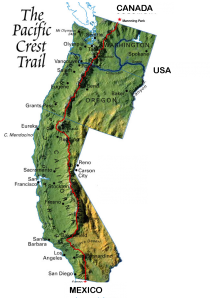I completed the Pacific Crest Trail (PCT) in 171 Days hiking from 23 March to 9 September 2019. I absolutely loved the trail. The variety was amazing, the people friendly and hospitiable and the wildlife interesting. it was definately a challenge as it was a high snow year so I spent a lot of time in the snow which I loved.
What is the Pacific Crest Trail?
The Pacific Crest Trail (PCT) is the second longest hiking trail in USA covering 4,265 km (2,650 miles) from the Campo on the Mexican Border to Manning Park, 17 km (11 miles) into Canada. The trail crosses desert, mountains, snow, forests, volcanic terrain and grasslands. The route passes through 25 national forests and 7 national parks. There is no hut system like New Zealand and 99% of nights will be spent in my tent.

The lowest point is 54 meters a.s.l. (180 feet) at the Columbia River Crossing and the highest point is 4009 meters a.s.l. (13,153 feet) at Forester Pass in the Sierra Nevada mountains. Overall there is 149,174 meters (489,418 feet) of climbing and 148,867 (488,411 feet) of descending. This is the equivalent of climbing up and down Mt Everest from sea level over 16 times!
It takes around 6.5 million steps and 4.5 to 5 months to complete the trail. The temperature will range from lows of -6oC (20oF) to highs of 37oC (100 oF). In the high temperatures water will be a major issue with some stretches between water sources of up to 53 km (33 miles), depending on how dry the year is. Thankfully this year has been very wet and lots of snow so far so I expect significantly shorter stretches but there will still be several stretches of over 32 km (20 miles)
Hikers burn an average of 5000 calaries per day and consume 4000 per day leading to significant weight loss. The amount of food carried averages between 5-7 days.
Wildlife will include; rattlesnakes, scorpians, bears, marmots, elk, mountain lions and lots of other reptiles and mammals.
The PCT was conceived by Clinton Churchill Clarke in 1932, was designated a National Scenic Trail in 1968 and was officially completed until 1993. More recently it was made famous in the Movie “Wild” ,starring Reece Witherspoon, which was based on the book of the same name by Cheryl Strayed.

Last year 4,997 people started the thru hike and 1149 reported completing the trail which is 23% success rate.
Why am I doing This?
I have loved my two previous long hikes and want to do another long hike that is different from the other two.
The Te Araroa Trail in New Zealand was my first long distance trail, covering 3000 km from the northern most to southern most point in New Zealand. This trail was everything I was hoping it would be. The terrain was varied, organisation easy and I got some excellent alone time. When I walked it in the 20014/15 season there were only around 300 people who walked the trail and it was very seldom that I saw other hikers. In 2018 the numbers had increased to around 1000 people doing the trail and there is now a different feel to it.
My next long trail was Norge Pa Langs in Norway in 2018. This trail is 2,700 km but I was only able to complete 2000 km in my 3 month visa time limit. The trail starts in the Arctic Circle in the northern most point in Norway and finishes at Lindesnes Lighthouse, the southernmost point. This trail was challenging to organise. There is no set route, so I had to find my own route by joining together separate trails. The distance between resupplies was long with several 9-day sections and one 12-day section. There were around 20 people attempting the trail that year. I never walked with other hikers and saw only 4 other hikers doing the trail. The trail was very remote in sections and I commonly went 5-7 days without seeing another person. The trail was rough in most places and there was no track for several sections requiring good navigation.
What I am expecting from the Pacific Crest Trail is outstanding scenery, wildlife and a more social experience. The trail logistics are easier as there is so much information and infrastructure supporting the trail. This includes the resupply towns and a large amount of ‘Trail Angels’ who are people who do ‘Trail Magic’ such as giving rides to towns, maintaining water caches in the desert and providing food for hikers. The trail is in much better condition so bigger mileages are expected. The key difference is the amount of people on the trail. I am not expecting the isolation I experienced on the other trails and am in two minds about this. I do want some periods on my own but will also enjoy sharing the experience with other hikers.
My key strategy for enjoying PCT is to have the mindset of not rushing. I have plenty of time to finish so intend to take it easy and spend time with like minded people and at particularly beautiful places.
Views: 6546
